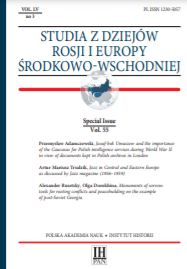The nationality panorama of Vilnius
The nationality panorama of Vilnius
Author(s): Aleksander SrebrakowskiSubject(s): Diplomatic history, Social history, Modern Age, Recent History (1900 till today), Demography and human biology
Published by: Instytut Historii im. Tadeusza Manteuffla Polskiej Akademii Nauk
Keywords: history of Vilnius; nationality composition of Vilnius; Polish-Lithuanian relations;
Summary/Abstract: Vilnius, the former capital of the Grand Duchy of Lithuania (GDL) is located at the junction of the Lithuanian and Belarusian ethnic areas. From its very foundation, the city had an ethnically mixed population. In addition to Lithuanians and Ruthenes, the ancestors of today’s Belarusians, it was also inhabited by Germans, Jews and Poles, and later by Tatars, Karaites, Russians and other nationalities. Already during medieval times, when the Polish-Lithuanian union was established, the gradual process of Polonising the city and its environs had begun. Especially after the Union of Lublin, the Polish language became dominant in the GDL capital. In the nineteenth century, with the rise of nationalism, when the inhabitants began to be asked to declare their nationality, Poles and Jews constituted a decided majority of the residents. Shortly before the outbreak of the First World War, Poles started to form an absolute majority in the city, and this state of affairs persisted after the end of the Second World War. In the post-war period, the number of Lithuanians in Vilnius grew slowly but steadily, reaching an absolute majority in 1989.
Journal: Studia z Dziejów Rosji i Europy Środkowo-Wschodniej
- Issue Year: 55/2020
- Issue No: Sp.
- Page Range: 33-56
- Page Count: 24
- Language: English

